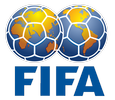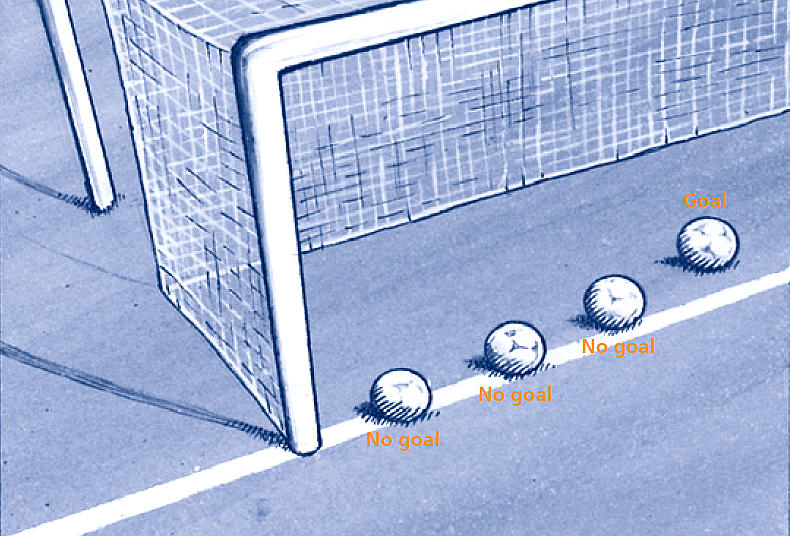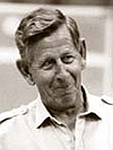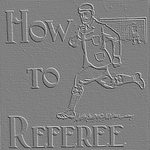| The Memories & Spirit of the Game, as only Ken Aston could teach it... |
| Enjoy, your journey here on... KenAston.org |
|
|
|
|
||
 |
Laws of 'The Game' as per... FIFA +-+ FIFA-ADDITIONAL +-+ +-+ ADVICE from 'THE PITCH' +-+ +-+ THE-PITCH Q & A +-+  |
 |
|
~ Downloadable MP3's for on the go study! ~ Goal Scored... +-+ Goal Scored... +-+ 
+-+ BACK TO TOP +-+ |
||||||||||
|
|
||
 |
FIFA Interpretation of the Laws of the Game and Guidelines for Referees |
 |
|
~ Downloadable MP3's for on the go study! ~ No Goal... +-+ No Goal... +-+ +-+ BACK TO TOP +-+ |
|
|
||
 |
ADVICE from 'THE PITCH' |

|
To recognize when a goal is scored correctly, and how to deal with illegal goals.
1. When is a Goal allowed?
2. When is a Goal isNOT
allowed
And here is an interesting point, "Did you know that it is actually almost impossible to score a goal as literally defined by the Laws of the Game?"
Law 10 states: "A goal is scored when the whole of the ball passes over
the goal line, between the posts and underneath the crossbar, provided
that no infringement of the Laws of the Game has been committed
previously by the team scoring the goal". But, it can be done. Straight from the kick-off!
3. Competition Rules
4. If a defender... not the goalkeeper
deliberately handles the ball in an attempt to prevent a goal.
5. Actions by Referee & Assistant
Referees when a goal is scored
See Law 6 The Assistant Referee
for more detail about communications between the Referee and his
Assistant Referees.
"The Referee may only
change a decision on realizing that it is incorrect or, at his
discretion, The Referee can indicate a goal by either blowing his whistle or pointing to the center circle. Or even by speaking!!!! It is generally obvious when a goal has been scored, therefore, on most occasions, no signal is required.
You should not turn your back immediately after a goal has been
scored - keep your eyes on the players
You do not necessary need to blow your whistle to indicate that a goal
has been scored. +-+ BACK TO TOP +-+
Questions and Answers:
Questions and Answers: I have listed several methods below: Question 9: Very often during a match, a change in the weather will caused the goal line to disappear between the goal posts. The movement of the goalkeeper over the line can also make it disappear. How does the Referee or Assistant Referees know when the ball has crossed this line, if the line does not exist any more? Answer 9: The portion of the goal line that runs between the goal posts is the most difficult part to mark out before each game - hence these lines are rarely what they should be. The Referee can ask for the lines to be marked correctly - nevertheless, if no marking equipment is available, the game should still be played. The Assistant Referee can use the upright goal posts to judge if a ball has entered the goal or not. The Referee will just have to use his judgment when allowing a goal to count or not. Question 10: I keep being told that the Referee is the sole judge whether a goal has been scored or not. Why can't the Assistant Referee decide when a goal has been scored or not, surely he is in a better position to see if the ball has crossed over the goal line and into the goal? Answer 10: Absolutely. The Referee and his two Assistant Referees are a team. The Assistant Referees are qualified Referees who are well capable of deciding if a goal has been scored or not. The Referee will have briefed his two Assistant Referees before the match, giving them instructions and responsibilities on what to do if they think a goal has been scored. As you say, the Assistant Referees are in a far better position to see if a disputed ball crosses the line or not. A good Referee will utilize his Assistants to the full - giving them many responsibilities that in turn help the Referee control the game better. If the Assistant Referee thinks that a goal has been scored - he usually indicates this by running quickly back up the touchline towards the halfway line. This indicates to the Referee that a goal has been scored. Some Assistant Referees flag to indicate that a goal has been scored - but flag signals can be misconstrued. A final point - the Referee should always look to his Assistants for help in such circumstances, but the Referee can overrule the Assistant Referee - albeit that it is not advisable to make a habit of this, as it will lead to a breakdown of the match officials' team. Question 11: During a game, an attacker shoots the ball towards goal. As the ball is making its way towards the goal, a spectator enters the field of play on the halfway line and starts to make his way towards the Referee. The ball crosses the goal line between the goal posts and the Referee blows for a goal. Why didn't the Referee stop play as soon as the spectator entered the field of play? Why isn't the goal disallowed - because of the outside interference of the spectator? Answer 11: The Referee may or may not have seen the spectator enter the field of play - either way, the Referee had decided to allow play to continue for a few moments because the outside interference did not actually make contact with the ball and had not interfered in any way with the play itself. In this instance, the ball (and play) was some 50 yards away from where the spectator entered the field of play. The Referee had allowed a few moments for the move to finish unaffected by the presence of the spectator. If the spectator had deflected the ball, or was able to affect the concentration of the players in any way, then the Referee has no option but to stop play and disallow any goal scored. A goal cannot be allowed in this instance, based on where the ball might have gone without any contact or interference by the spectator. The correct restart would be a dropped ball at the place where play was interfered with (keeping in mind the special circumstances outlined in Law 8 when a dropped ball is taken on a point on the 6 yard line parallel to where the interference happened - if it occurred in the goal area.) Question 12: If the Referee has missed a goal that the Assistant Referee has seen, how long should the Assistant Referee keep his flag up before the goal counts? Answer 12: The Assistant Referee should try his very best to gain the Referee's attention before the Referee restarts play. Players, spectators and team officials will also help by calling out to the Referee. Law 5 states that the Referee may only change a decision on realizing that it is incorrect or, at his discretion, on the advice of an Assistant Referee, provided that the Referee has not restarted play. If the Referee does not see the Assistant's signal, and restarts play (with a throw-in or goal kick for example) then the goal cannot be allowed in accordance with Law 5. It is therefore vitally important that the Assistant Referee gains the attention of the Referee before play is restarted. Question 13: During a match, an attacking player kicks the ball strongly towards goal, the ball shoots towards the base of one of the posts. The next thing I see is the ball traveling some twenty yards behind the goal and out of the field of play - but the Referee has awarded a goal. Surely the ball must be in the back of the net before a goal can be allowed? Answer 13: The goal was awarded because the ball entered the goal just inside the goal post and immediately exited through a small hole in the goal net close to the ground near the base of the goal post. The Referee had obviously seen that the ball had entered the goal, hence the goal was allowed. It is very important to thoroughly check the goal nets before kick-off. It can be very difficult for a Referee to see whether a ball has entered the goal if he is many yards away trying to catch up with play. The most vulnerable part of the goal net is the attachment at the base of each post. A ball aimed at this area is very difficult to judge. I always take small lengths of string to my matches, and am not too proud to tie the nets myself in places where they show any weakness. The Referee can ask the Home team to repair the nets before kick-off - but invariably (at Park level) nobody ever seems to have any string or 'ties'. By ensuring that the nets are properly secured, I increase my confidence at being able to make the correct decisions during the match should the ball end up outside the net during a shot on goal. This makes me more relaxed and able to officiate with more confidence. Question 14: A Referee blows his whistle to signal that a goal has been scored just before the ball has passed wholly over the goal line, and a defending player clears the ball off the goal line. The Referee suddenly realizes that he has made a mistake - should he allow the goal to count - if not, then how should the game be restarted? Answer 14: The goal does not count because the ball had not wholly crossed the goal line. The Referee should restart with a dropped ball on the goal area line, parallel to the goal line, at the point nearest to where the ball nearly entered the goal. Question 15: If an attacking player shoots towards an empty goal, and the ball is stopped from entering the goal by a dog that has run onto the field of play - should the goal be allowed to count? Answer 15: No. A dog on the field of play is classified as an external interference. If the dog deflects the ball, or was able to affect the concentration of the players, then the Referee has no option but to stop play and disallow any goal scored. A goal cannot be allowed in this instance, based on where the ball might have gone in the absence of the dog. The correct restart is a dropped ball at the place where play was interfered with (keeping in mind the special circumstances outlined in Law 8 when a dropped ball is taken on a point on the goal line parallel to where the interference happened - if it occurred in the goal area.) If a dog, any other animal or child enters the field, the Referee should suspend play until the obstacle is cleared away. Question 16: Can a goal be scored after the Referee has blown his whistle to stop play? Answer 16: No. A goal can only be scored during periods of play. Balls that enter the goal after the Referee has blown his whistle to stop play do not count. Referees should only signal that a goal has been scored when they are absolutely sure that the ball has wholly crossed the goal line, beneath the crossbar and between the goal posts. If the Referee stops play for an infringement before the ball has wholly crossed the goal line, the goal is not valid, and the match should be restarted according to the nature of the infringement. Question 17: If an attacking player fouls an opponent in an attempt to prevent a goal (and the Referee does not signal to stop play) but the ball continues on into the goal, does the Referee have to award a free kick or penalty to the attacking team, for the foul previously committed? Answer 17: No. The Referee should allow a few moments to allow any advantage to accrue for the attacking team. In this case, the goal is a better advantage award than a free kick. The goal is valid and the defending player can be cautioned or sent off, depending on the nature of the foul. If an attacking team infringes any of the Laws of the Game before scoring a goal, then the goal is not valid. Question 18: During an indirect free kick, an attacking player blasts the ball directly towards goal. The defending goalkeeper makes no attempt to save the ball from going in the net - but just stands there watching the ball enter his goal - whatever is he doing? Answer 18: A goal cannot be scored direct from an indirect free kick (Law 13). The ball must touch another player before a goal can be valid. The goalkeeper was aware of this stipulation, but the attacking kicker was not. Question 19: If an Assistant Referee witnesses (and signals for) an act of violent conduct by the attacking team, unseen by the Referee, and play continues and a goal is subsequently scored - what action should the Referee take if he then sees his Assistant's signal? Answer 19: As long as the Referee has not restarted play with a kick off, the goal should be disallowed and the guilty player sent-off for violent conduct. The match should be restarted with a direct free kick at the place where the incident occurred. Question 20: Nigerian Finidi George was involved in a goal celebration whilst playing in Spain, which involved the wearing of a cowboy hat. How would a British Referee deem the use of props such as this for a post-goal piece of fun? Is there a ruling? Answer 20: The FIFA ruling (Season 2001/2002) on celebrating a goal was as follows: "The Board recognized that the celebration of a goal was an important and emotional part of football and relaxed the earlier statement in FIFA Circular 579 of 23 January 1996 that any player removing the jersey while celebrating a goal should be cautioned. Players will no longer be cautioned if they remove their shirt but they will be cautioned for unsporting behavior if their celebrations are provocative and intended to incite or ridicule opponents or opposing spectators. Players guilty of excessive time-wasting while celebrating a goal will also be cautioned." In this respect, the International Football Association Board and FIFA recognize the natural and emotional joy of scoring goals, and the need for players to show (and release) their emotions after a goal has been scored. Although this new FIFA ruling is not actually incorporated into the Laws of the game, Referees will be instructed to use their common sense and take a rather more laid-back approach to goal celebrations. So long as there is no wasting time or inciting the crowd or unsporting behavior or anything obscene- the emphasis is for Referees to lighten-up when players are celebrating the scoring of goals. Notwithstanding this, players at the top level also have a responsibility not to turn such celebrations into a circus. There was an occasion some years ago, in South America when "The Great Carrot Controversy" broke out. Atletico Mineiro striker Edmilson Ferreira celebrated scoring a 20th-minute goal in the Brazilian championship game against close rival America-Belo Horizonte by pulling a carrot from his shorts and munching on it. "What's up, doc?" The consequences were that crowd trouble ensued both during the game and for many games after. There was a proactive attempt in Britain by soccer officials in the 1990’s, assisted by the police, to ‘crack-down’ on provocative gestures in the Premier League games – and to some extent, this has worked. The types of goal celebrations that can not be tolerated, are goalkeeper Mark Bosnich's Nazi-style salute to the crowd: Goal line (cocaine type) sniffing by Liverpool’s Robbie Fowler.: and players running into the crowd to celebrate. It was not so long ago that players were indeed celebrating goals by getting together and playacting out scenarios (such as the rocking of a baby for those players who had just become fathers). There was nothing much wrong with this – on the contrary, it seemed to be the only time that players managed to put a smile on their faces in what is quickly becoming a far too serious (die for your team/football is more important than life) sport. Players very often throw themselves across the grass like skydivers joining hands in a human star-like formation. They have been known to flap in formations like roosters; waddle like ducks; form chorus-lines, or even in the case of Nigerian World Cup star Finidi George, following his goal in the 1994 World Cup, crawl to a corner flag, raise his ‘hind’ leg and pretend to use the corner flag as a dog does on a lamp post. The scoring of a goal is a highly emotional time. Argentine striker Gabriel Batistuta once said, "Goals are like bread. I need them to live." And Latin American announcers have their own ritual, by screaming out "GOOOOOOOOOOOOOOOOOOOAAAL!!!" after each score. The safety of everyone involved is paramount during goal celebrations. Supporters could be seriously hurt in any ensuing crush. Officials and Football Associations want to discourage the bad types of behavior – at the same time, they have re-recognized that emotion is spontaneous, and so long as it does not endanger anyone, or wastes time, then it should be allowed to naturally express it. And let’s face it, certainly does add a touch of humor to the game. Question 21: If an attacking player with plenty of time and no goalkeeper in front of him, gets on his knees and heads the ball on the ground into his opposition's open net, is this a goal? Answer 22: As long as the player does not score a goal with his hand, or no other infringement of the Laws has occurred, a player can use any part of his anatomy to score a goal. Although this method is sometimes used in a 'fun type' way, it has sometimes been used to poke fun at the opposition team. But there is not much the Referee can do about this. It is a legal goal. It could be argued that placing your head in this position is tantamount to enticing dangerous play. If a player does this whilst there are opposition players very near to him who are making a play for the ball, the Referee could by Law 12, stop play for dangerous play and restart with an indirect free kick to the attacking team, taken from the goal area line parallel to the goal line at the point nearest to where the dangerous play happened in the goal area. Thanks to Jed Dugish for this interesting question. |
||||||||||||||||
|
|
| +-+ BACK TO TOP +-+ +-+ FIFA-ADDITIONAL +-+ +-+ ADVICE from 'THE PITCH' +-+ +-+ THE-PITCH Q & A +-+ |
|